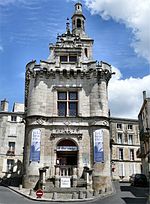| Revision as of 19:10, 21 December 2024 editDormskirk (talk | contribs)Autopatrolled, Extended confirmed users, Pending changes reviewers, Rollbackers411,159 edits →History: tweak← Previous edit | Revision as of 19:13, 21 December 2024 edit undoDormskirk (talk | contribs)Autopatrolled, Extended confirmed users, Pending changes reviewers, Rollbackers411,159 edits →History: expandNext edit → | ||
| Line 23: | Line 23: | ||
| ==History== | ==History== | ||
| ] | |||
| The first town hall in Niort was at the corner of Rue du Rempart and Rue Ricard. The aldermen relocated to an early iteration of the Pilori (the Pillory) in 1370: this square-shaped building, designed in the ], was re-built by the master mason, Mathurin Berthomé, in 1535.<ref>{{cite web|url= https://www.niortmaraispoitevin.com/en/patrimoine-culturel/le-pilori-espace-darts-visuels/ |title= Le Pilori – Espace d'arts visuels|publisher= Niort Marais Poitevin Tourisme| access-date=20 December 2024}}</ref><ref>{{cite web|url= https://monumentum.fr/monument-historique/pa00101287/niort-ancien-hotel-de-ville-dit-le-pilori|title= Former town hall, known as Le Pilori|publisher=Monumentum| access-date=20 December 2024}}</ref> After the ], the council was based at the governor's house in the grounds of the ].<ref>{{cite web|url= https://www.vivre-a-niort.com/services-publics/annuaire-des-services/coordonnees/hotel-de-ville/index.html |title=Hôtel de Ville|publisher=Vivre à Niort|access-date=20 December 2024}}</ref> | The first town hall in Niort was at the corner of Rue du Rempart and Rue Ricard. The aldermen relocated to an early iteration of the Pilori (the Pillory) in 1370: this square-shaped building, designed in the ], was re-built by the master mason, Mathurin Berthomé, in 1535.<ref>{{cite web|url= https://www.niortmaraispoitevin.com/en/patrimoine-culturel/le-pilori-espace-darts-visuels/ |title= Le Pilori – Espace d'arts visuels|publisher= Niort Marais Poitevin Tourisme| access-date=20 December 2024}}</ref><ref>{{cite web|url= https://monumentum.fr/monument-historique/pa00101287/niort-ancien-hotel-de-ville-dit-le-pilori|title= Former town hall, known as Le Pilori|publisher=Monumentum| access-date=20 December 2024}}</ref> After the ], the council was based at the governor's house in the grounds of the ].<ref>{{cite web|url= https://www.vivre-a-niort.com/services-publics/annuaire-des-services/coordonnees/hotel-de-ville/index.html |title=Hôtel de Ville|publisher=Vivre à Niort|access-date=20 December 2024}}</ref> | ||
Revision as of 19:13, 21 December 2024
Town hall in Niort, France
| Hôtel de Ville | |
|---|---|
 The main frontage of the Hôtel de Ville in August 2008 The main frontage of the Hôtel de Ville in August 2008 | |
| General information | |
| Type | City hall |
| Architectural style | Renaissance Revival style |
| Location | Niort, France |
| Coordinates | 46°19′25″N 0°27′53″W / 46.3237°N 0.4648°W / 46.3237; -0.4648 |
| Completed | 1901 |
| Design and construction | |
| Architect(s) | Georges Lasseron |
The Hôtel de Ville (French pronunciation: [otɛl də vil], City Hall) is a municipal building in Niort, Deux-Sèvres, western France, standing on Place Martin-Bastard. It was designated a monument historique by the French government in 2015.
History

The first town hall in Niort was at the corner of Rue du Rempart and Rue Ricard. The aldermen relocated to an early iteration of the Pilori (the Pillory) in 1370: this square-shaped building, designed in the medieval style, was re-built by the master mason, Mathurin Berthomé, in 1535. After the French Revolution, the council was based at the governor's house in the grounds of the Donjon de Niort.
In the late 19th century, the town council decided to commission a new town hall. The site they selected was occupied by the old Collège de l'Oratoire (College of the Oratory of Jesus), which was established in Niort in 1617. The foundation stone for the new building was laid by the president of France, Félix Faure, on 27 April 1897. It was designed by Georges Lasseron in the Renaissance Revival style, built in ashlar stone and was officially opened by the mayor, Ludovic Martin-Bastard, and the minister of justice, Ernest Monis, over several days between 25 and 28 May 1901.
The design involved a symmetrical main frontage of 11 bays facing onto the market square (now known as Place Martin-Bastard) with the end bays projected forward as pavilions. The central bay featured a round headed opening with a moulded surround and a keystone. The other bays on the ground floor in the central section were fenestrated by round headed windows, while the bays on the first floor were fenestrated with square headed windows. The end bays were fenestrated in a similar style and were surmounted by pyramid-shaped roofs with dormer windows. There were fine carvings between each of the bays on the first floor of the central section and there was a clock, supported by ornate carvings and surmounted by a coat of arms, above the central three bays. A tall octagonal belfry was erected behind the clock. Internally the principal rooms are the Salle de Conseil (council chamber) and the Salle de Mariages (wedding room). The paintings for these rooms were created by Charles Fouqueray.
In the early 21st century, two curved annexes were built to the east of the town hall to accommodate the demands for space for extra administrative staff: these buildings were designed by Jean-François Milou, and completed in March 2000.
References
- Base Mérimée: PA79000045, Ministère français de la Culture. (in French)
- "Le Pilori – Espace d'arts visuels". Niort Marais Poitevin Tourisme. Retrieved 20 December 2024.
- "Former town hall, known as Le Pilori". Monumentum. Retrieved 20 December 2024.
- "Hôtel de Ville". Vivre à Niort. Retrieved 20 December 2024.
- "Ce que l'on sait sur l'ancien oratoire à Niort, après la découverte de vestiges au pied de la mairie". Ouest France. 9 March 2023. Retrieved 20 December 2024.
- "Sous la place de la mairie de Niort, des fouilles révèlent les vestiges d'un ancien oratoire". France Bleu. 16 March 2023. Retrieved 20 December 2024.
- Houteiller, J.-A. (1865). L'oratoire et le collège di Niort: Notice historique (PDF). E. Aubert. p. 8.
- "Hôtel de Ville de Niort". Niort Marais Poitevin Tourisme. Retrieved 20 December 2024.
- "XXe et XXIe siecles". Vivre à Niort. Retrieved 20 December 2024.
- "Hôtel de ville de Niort". PSS Architecture. Retrieved 20 December 2024.
- "Charles Fouqueray (1869–1956): "Sea Salvage"". Proantic. 1939. Retrieved 20 December 2024.
- "Hôtel Administratif, Niort, France". Studio Milou & Porter. Retrieved 20 December 2024.